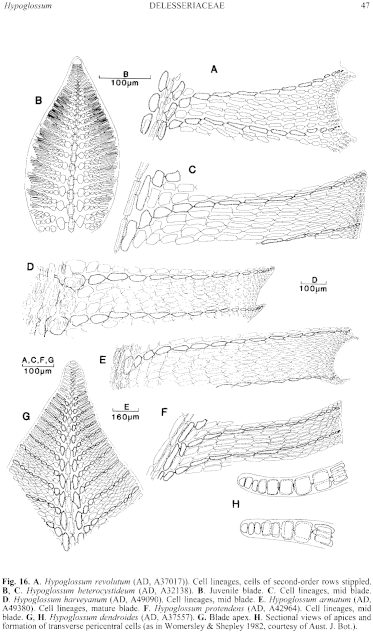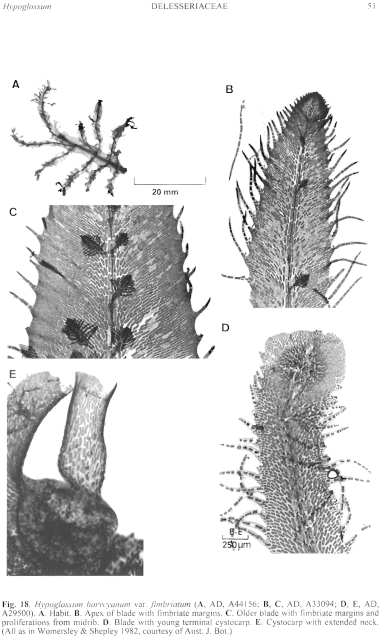|
|
|
|
|
|||||||||||
|
Electronic Flora of South Australia Species Fact Sheet
Phylum Rhodophyta – Family Delesseriaceae
Selected citations: Lewis 1984: 46. Millar 1990: 426, fig. 57A–D. Millar & Kraft 1993: 46. Silva et al. 1996: 458. Wynne 1989a: 514, fig. 2B.
Synonyms
Delesseria harveyana J. Agardh 1872: 57; 1876: 490. Sonder 1880: 24.
Delesseria serrulata Harvey 1858: pl. 59; 1863, synop.: xxxi. [NON D. serrulata Harvey 1857: 331 from Japan.]
Hypoglossum serrulatum (Harvey) J. Agardh 1898: 186. De Toni 1900: 690. Kylin 1924: 9. Lucas 1909: 36.
Thallus (Fig. 17A) light to medium red, 10–40 cm high, usually profusely branched to four or five orders, with a single main axis often (0.2–) 0.5–1 cm broad with a prominent corticate midrib 1–2 mm broad, giving rise to long laterals from both surfaces of the main blade. Main laterals usually 5–20 cm long, branched on both sides, but tertiary branches arising mainly abaxially. Cortication commences close to the apices, with the first three orders of branches in mature plants with a thick, corticated midrib, and the lower main axes and branches often becoming denuded. In older branches, where the midrib is moderately or heavily corticated, corticating filaments develop between the cells of the lamina of the blades, at first adjacent to the midrib and later spreading over the whole surface of the blades. Margins of young blades regularly and prominently serrate, often denuded below. Holdfast small, discoid; probably epilithic. Structure. All second-order cells (except marginal spine cells) produce third-order cell rows (Figs 16D, 17B, D), in both vegetative and fertile blades. At the margin of the blade (Fig. 16D), 1–3 subapical second-order cells remain undivided and, together with the third-order rows derived from several adjacent second-order cells, project beyond the older third-order cell rows and provide the regular serrations. In var. fimbriatum (see below), the second-order rows on older (lower) parts of the blades extend as uniseriate rows of 5–20 (–25) cells. Such fimbriate blades may occur on non-fimbriate parent blades, and variations from the normal spinous blades to fimbriate ones occur in the limited range of plants observed. Cells multinucleate; rhodoplasts discoid becoming chained.
Reproduction: Gametophytes dioecious. Procarps not observed. Carposporophytes dense, with numerous much branched gonimoblast filaments producing terminal and lateral carposporangia maturing sequentially and often forming short chains with only the terminal 2 or 3 mature at any time, subspherical to ovoid or pyriform, 30–50 (–100) µm in diameter. Cystocarps developing abaxially (occasionally adaxially) close to the apices of ultimate and penultimate blades, often with two cystocarps on one blade. Mature cystocarps (Fig. 17C) 500–800 µm in diameter, not basally constricted but forming a prominent protrusion abaxially on the blade with only a slight bulge on the adaxial surface, ostiolate with a neck 100–250 µm long (Fig. 17C, arrow). Pericarp lightly corticated, 2 or 3 cells thick, with internal, slender, rhizoidal filaments. Spermatangial sori (Fig. 17D, E) on ultimate and penultimate blades extending 0.5–0.75 of the distance from midrib to margin, and often with sterile second-order cell rows within the sorus.
Tetrasporangial sori (Fig. 17F) on the ultimate and penultimate blades, with the sorus occupying about one-third of the blade width and up to three-quarters of the blade length. In penultimate blades several sori may develop in sequence. The lateral pericentral cells cut off, at much the same time, a tetrasporangial initial anteriorly and a corticating cell outwardly. This corticating cell divides rapidly to form a further outer layer of 2–4 corticating cells and in many cases cuts off anteriorly a darkly-staining incipient tetrasporangial initial. The tetrasporangia attached to the lateral pericentral cells and cells of the second- and third-order rows develop and mature most rapidly, but older sori contain tetrasporangia of mixed ages. The transverse pericentral cells produce corticating cells but only rarely do they produce functional tetrasporangia. Mature tetrasporangia are 55–100 µm in diameter. In older blades many marginal and near-marginal proliferations may develop and bear tetrasporangial sori.
Type from Port Jackson, N.S.W. (Moore) (Harvey, Alg. Aust. Exsicc. 277L); lecotype Herb. Agardh, LD, 31545.
Selected specimens: Port Jackson, N.S.W. (Harvey, Mg. Aust. Exsicc. 277L; BM). Botany Bay, N.S.W. (Lucas, Jan. 1905; AD, A38745, and 30 sheets collected between June 1909 and Jan. 1912 in NSW). Off Carters I., Georges R. estuary, Botany Bay, N.S.W., 3 m deep on shells (Larkum, 12.i.1978; AD, A49090). Mary R. Heads, Qld (McKeon, 4.viii.1959; AD, A23289). Kite I., Calliope R., Gladstone, Qld, 1 m deep (Moverly, 25.viii.1977; AD, A50523).
Distribution: Known from Port Jackson and Botany Bay, N.S.W., Mary R. heads and Gladstone, Qld, 1–8 m deep. Var. fimbriatum (see below) from Port Turton, S. Aust., and Saunders Beach, Kangaroo I., S. Aust.
Taxonomic notes: Delesseria harveyana J. Agardh is based on Harvey's Alg. Aust. Exsicc. 277L from Port Jackson, N.S.W. The two specimens in TCD are labelled ‘Paramatta R., C. Moore’, and Harvey (1858, pl. 59) stated the only specimens he had were from Charles Moore. The specimens probably came from the Paramatta R. estuary which flows into Port Jackson; this probably was a comparable habitat to the Carters I. locality. Harvey (1857b, no. 277) first named the species 'D. serrata', this name appearing on the C. Moore sheets, with the later addition of 'D. serrulata'. Harvey (1858, pl. 59) referred to the species as D. serrulata, presumably because of the earlier D. serrata Postels & Ruprecht, which is now recognised as Membranoptera serrata (Postels & Ruprecht) Zinova (see Wynne 1970, p. 99).
However, Delesseria serrulata Harvey was first described by Harvey (1857a, p. 331), based on material from Hakodate, Japan, and Harvey in 1858 mistakenly considered the Port Jackson material the same species. J. Agardh (1872) realised the Australian material was distinct from the Japanese, and renamed the former D. harveyana. J. Agardh (1872, p. 58) also renamed the Japanese taxon D. violacea, but this is invalid and the Japanese taxon is correctly known as Delesseria serrulata Harvey (see Yoshida 1998, p. 971).
H. serrulatum was recorded from the Indonesian region by Weber-van Bosse (1923, p. 389), but without adequate details to verify the species.
References:
AGARDH, J.G. (1872). Bidrag till Florideernes Systematik. Acta Univ. Lund 8, 1–60.
AGARDH, J.G. (1876). Species Genera et Ordines Algarum. Vol. 3, Part 1 - Epicrisis systematis Floridearum, pp. i-vii, 1–724. (Weigel: Leipzig.)
AGARDH, J.G. (1898). Species Genera et Ordines Algarum. Vol. 3, Part 3 - De dispositione Delesseriearum. (Gleerup: Lund.)
DE TONI, G.B. (1900). Sylloge Algarum omnium hucusque Cognitarum. Vol. 4. Florideae. Sect. 2. pp. 387–776. (Padua.)
HARVEY, W.H. (1857a). Algae. In A. Gray, "Account of the Botanical specimens," pp. 331–332. Narrative of the Expedition of an American Squadron to the China seas and Japan, Vol. II.
HARVEY, W.H. (1857b). List of Dr Harvey's duplicate Australian algae.
HARVEY, W.H. (1858). Phycologia Australica. Vol. 1, Plates 1–60. (Reeve: London.)
HARVEY, W.H. (1863). Phycologia Australica. Vol. 5, Plates 241–300, synop., pp. i-lxxiii. (Reeve: London.)
KYLIN, H. (1924). Studien über die Delesseriaceen. Lunds Univ. Årsskr. N.F. Avd. 2, 20(6), 1–111.
LEWIS, J.A. (1984). Checklist and bibliography of benthic marine macroalgae recorded from northern Australia. I. Rhodophyta. Dept. Defence, Materials Res. Lab., Melbourne, Vic. Report MRL-R-912.
LUCAS, A.H.S. (1909). Revised list of the Fucoideae and Florideae of Australia. Proc. Linn. Soc. N.S.W. 34, 9–60.
MILLAR, A.J.K. & KRAFT, G.T. (1993). Catalogue of marine and freshwater Red Algae (Rhodophyta) of New South Wales, including Lord Howe Island, South-western Pacific. Aust. Syst. Bot. 6, 1–90.
MILLAR, A.J.K. (1990). Marine Red Algae of the Coffs Harbour Region, northern New South Wales. Aust. Syst. Bot. 3, 293–593.
SILVA, P.C., BASSON, P.W. & MOE, R.L. (1996). Catalogue of the Benthic Marine Algae of the Indian Ocean. (Univ. California Press: Berkeley.)
SONDER, O.W. (1880). In Mueller, F., Fragmenta Phytographiae Australiae. Supplementum ad volumen undecinum: Algae Australianae hactenus cognitae, pp. 1–42, 105–107. (Melbourne.)
WEBER-VAN BOSSE, A. (1923). Liste des Algues du Siboga. III. Rhodophyceae. Seconde parte. Ceramiales. Siboga-Expeditae, Monogr. 59c, pp. 311–392, Plates IX, X. (Leiden.)
WOMERSLEY, H.B.S. & SHEPLEY, E.A. (1982). Southern Australian species of Hypoglossum (Delesseriaceae, Rhodophyta). Aust. J. Bot. 30, 321–346.
WYNNE, M.J. (1989a). A reassessment of the Hypoglossum group (Delesseriaceae, Rhodophyta), with a critique of its genera. Helgol. Meeresunters. 42, 511–534.
YOSHIDA, T. (1998). Marine Algae of Japan. (Uchida Rokakuho Publ. Co.: Tokyo.)
The Marine Benthic Flora of Southern Australia Part IIID complete list of references.
Publication:
Womersley, H.B.S. (24 February, 2003)
The Marine Benthic Flora of Southern Australia
Rhodophyta. Part IIID. Ceramiales – Delesseriaceae, Sarcomeniaceae, Rhodomelaceae
Reproduced with permission from The Marine Benthic Flora of Southern Australia Part IIID 2003, by H.B.S. Womersley. Australian Biological Resources Study, Canberra. Copyright Commonwealth of Australia.
Illustrations in Womersley Part IIIA, 2003: FIGS 16D, 17, 18.

Figure 16 enlarge
Fig. 16. A. Hypoglossum revolutum (AD, A37017)). Cell lineages, cells of second-order rows stippled. B, C. Hypoglossum heterocystideum (AD, A32138). B. Juvenile blade. C. Cell lineages, mid blade. D. Hypoglossum harveyanum (AD, A49090). Cell lineages, mid blade. E. Hypoglossum armatum (AD, A49380). Cell lineages, mature blade. F. Hypoglossum protendens (AD, A42964). Cell lineages, mid blade. G, H. Hypoglossum dendroides (AD, A37557). G. Blade apex. H. Sectional views of apices and formation of transverse pericentral cells (as in Womersley & Shepley 1982, courtesy of Aust. J. Bot.).

Figure 17 enlarge
Fig. 17. Hypoglossum harveyanum (from N.S.W.) (A, AD, A38745, B–F, AD, A49090). A. Habit. B. Apex showing segmentation. C. Cystocarp with neck (arrow). D. Blade with spermatangial sori. E. Detail of spermatangial sori. F. Blade with a tetrasporangial sorus. (A, B, D–F as in Womersley & Shepley 1982, courtesy of Aust. J. Bot.)

Figure 18 enlarge
Fig. 18. Hypoglossum harveyanum var. fimbriatum (A, AD, A44156; B, C, AD, A33094; D, E, AD, A29500). A. Habit. B. Apex of blade with fimbriate margins. C. Older blade with fimbriate margins and proliferations from midrib. D. Blade with young terminal cystocarp. E. Cystocarp with extended neck. (All as in Womersley & Shepley 1982, courtesy of Aust. J. Bot.)

|
Email Contact: State Herbarium of South Australia |

|